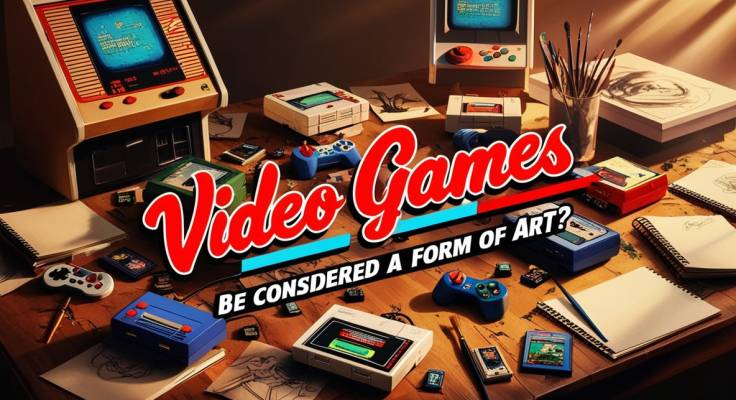Can Video Games Be Considered a Form of Art?
- Landon White
- 22 Oct, 24

The debate over whether video games qualify as a form of art has been a topic of intense discussion among critics, gamers, and artists alike. As technology advances and storytelling techniques evolve, video games have transformed into immersive experiences that engage players on multiple levels. By examining various aspects such as narrative depth, visual aesthetics, gameplay mechanics, and emotional impact, we can explore the artistic merits of this interactive medium.
Interactive Narratives: Crafting Complex Story Worlds
One of the most compelling arguments for video games as art lies in their ability to tell intricate stories that rival those of literature and film. Games like The Witcher 3: Wild Hunt and Detroit: Become Human offer branching narratives that adapt to player choices, creating personalized experiences. These games delve into themes of morality, identity, and societal norms, encouraging players to reflect on their decisions and the consequences that follow. The interactive nature of these narratives adds a layer of engagement that traditional storytelling mediums cannot replicate, allowing players to become co-authors of their own stories.
Visual Symphony: The Art of Game Design
The visual component of video games showcases a spectrum of artistic styles and innovations. From the minimalist design of Inside to the vibrant landscapes of Horizon Zero Dawn, developers utilize visual elements to create atmospheres that enhance storytelling and gameplay. Games like Okami employ traditional Japanese ink wash painting techniques, while Gris uses color and animation to represent the protagonist's emotional journey. These visual choices are not merely aesthetic but serve as integral components of the overall experience, much like the brushstrokes of a painter convey meaning and emotion.
Musical Landscapes: Composing the Sound of Emotion
Music in video games is a powerful tool that shapes the player's emotional response. Composers such as Gustavo Santaolalla for The Last of Us and Mick Gordon for DOOM create scores that are as memorable as they are impactful. The music adapts to gameplay, intensifying during action sequences and calming during exploration, guiding the player's emotional journey. These soundtracks often gain recognition outside the gaming community, further highlighting their artistic value.
Gameplay Mechanics: Innovation Through Interaction
Gameplay mechanics are the heart of the video game experience, and innovative designs can elevate a game to an art form. Titles like Journey offer minimalist mechanics that focus on exploration and emotional connection without the need for dialogue. Celeste combines challenging platforming with a narrative about mental health, using gameplay to mirror the protagonist's struggles. The way a game feels and responds to player input is a form of expression, conveying themes and emotions through interaction.
Emotional Resonance: Connecting on a Personal Level
Video games have the unique ability to foster deep emotional connections through their interactive nature. Experiences such as Firewatch and To the Moon invite players into intimate narratives that explore human relationships and personal loss. The immersion provided by controlling a character and influencing the story allows for a level of empathy and emotional investment that can be profound, demonstrating the medium's capacity to move players in meaningful ways.
Cultural Commentary: Reflecting and Shaping Society
Many games tackle complex social and political issues, using the medium to comment on real-world problems. Papers, Please places players in the role of an immigration officer in a dystopian society, forcing them to make ethical decisions under pressure. Spec Ops: The Line challenges perceptions of war and heroism, prompting players to question the morality of their actions. By engaging with these themes, video games contribute to societal discourse, much like traditional art forms have done throughout history.
Collaborative Creation: The Artistry Behind Development
The process of creating a video game is inherently artistic, involving collaboration among writers, artists, musicians, and programmers. This multidisciplinary approach results in works that are greater than the sum of their parts. Indie games like Undertale showcase how small teams can produce impactful experiences through creative storytelling and unique design choices. The collaborative nature of game development mirrors that of other art forms, such as theater and film, where various talents converge to create a unified vision.
Technological Innovation: Expanding Artistic Boundaries
Advancements in technology have opened new avenues for artistic expression within video games. Virtual reality experiences like Beat Saber and Moss immerse players in worlds that feel tangible and responsive. Procedural generation in games like No Man's Sky creates vast, unique universes for players to explore, pushing the limits of what is possible in a digital space. These innovations not only enhance gameplay but also provide new tools for artists to express their creativity.
Community Engagement: Art Beyond the Screen
The impact of video games extends beyond the screen through fan art, cosplay, and community events. Players often create their own content inspired by games, such as artwork, music remixes, and mods, contributing to the cultural footprint of the original work. Events like gaming conventions and online forums foster communities that celebrate and critique games, much like art exhibitions and literary circles. This active participation highlights the medium's ability to inspire creativity and dialogue among its audience.
Educational Potential: Learning Through Play
Video games are increasingly recognized for their educational value, using interactive storytelling to teach and inform. Games like Never Alone share indigenous Alaskan culture and folklore, preserving stories through gameplay. Historical games such as Valiant Hearts: The Great War provide insights into World War I, combining factual information with emotional narratives. By engaging players in active learning, video games offer unique educational experiences that traditional methods may not achieve.
Therapeutic Applications: Healing Through Interaction
The therapeutic potential of video games is another facet of their artistic merit. Games are used in healthcare settings to aid in physical rehabilitation, cognitive training, and mental health therapy. Titles like Sea of Solitude address topics like loneliness and depression, providing players with a space to explore and understand these feelings. The interactive nature of games allows for personalized experiences that can support emotional healing and personal growth.
Global Diversity: A Mosaic of Cultural Expressions
The global nature of the gaming industry brings together diverse cultural influences, enriching the medium's artistic tapestry. Games developed in different regions incorporate local myths, architectural styles, and storytelling traditions. For example, Never Alone explores Alaskan Native culture, while Mulaka is based on the indigenous Tarahumara people's mythology. This diversity allows players worldwide to experience and appreciate cultures different from their own, promoting understanding and empathy.
Recognition in the Art World: Bridging the Gap
Video games are increasingly finding recognition in traditional art spaces. Exhibitions like "The Art of Video Games" at the Smithsonian American Art Museum have showcased games as artistic works worthy of preservation and study. Artists and designers from the gaming industry are gaining acclaim for their contributions, further blurring the lines between video games and accepted art forms. This institutional recognition is a significant step toward acknowledging the artistic value of video games.
The Evolving Medium: Future Possibilities
The potential for video games as an art form continues to grow as developers push creative boundaries. Emerging technologies like artificial intelligence and advanced physics engines allow for more dynamic and responsive worlds. Indie developers are exploring unconventional narratives and gameplay mechanics, challenging players' expectations and expanding the medium's scope. As the industry evolves, so does the opportunity for video games to offer new and profound artistic experiences.
Challenging Preconceptions: Redefining Art in the Digital Age
The hesitation to accept video games as art often stems from outdated perceptions of what art can be. Just as film and photography were once dismissed, video games challenge traditional definitions by combining interactivity with artistic expression. By embracing the medium's unique qualities—its ability to engage, immerse, and provoke thought—we can recognize video games as a legitimate and valuable form of art in the digital age.














